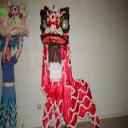Yahoo Answers is shutting down on May 4th, 2021 (Eastern Time) and beginning April 20th, 2021 (Eastern Time) the Yahoo Answers website will be in read-only mode. There will be no changes to other Yahoo properties or services, or your Yahoo account. You can find more information about the Yahoo Answers shutdown and how to download your data on this help page.
Trending News
What does the term "stance" mean to you?
What is the point of a "stance" in your martial art? Of what use are stances?
Thanks everyone. I wanted to see if my take on stance is the same as other instructors.
Thanks Tom, until your answer, I thought it was the wrong category! Good answer Tom.
I was trying to clarify that stance is way more than just a place to stand, it is technique too.
Many good answers from the regulars, great answers folks!
18 Answers
- 7 years agoFavorite Answer
Stances teach you certain aspects concerning martial arts and how better to defend yourself. Things like weight distribution as it applies to attacking or defending, how to better distribute your weight for kicking and with which leg, either front or back as well as what angles of attack you can more easily use or apply as well as what angles you need to be more concerned about because you are more vulnerable to an attack on those angles. They also teach you how better to move and what way to move to execute things that you might want to do and being able to execute them more effectively.
Unfortunately many schools and instructors don't teach at that level of detail and so much of this is lost to most martial arts students these days. They are not taught for instance that in a cat stance or nekoashi dachi that you are less susceptible to low kicks directly at your groin from one side and the angles your front leg closes off (depending on which leg you have positioned in front of course) but yet that stance is taught quite a bit in most schools.
You do see this level of detail taught and emphasized in fighting arts like boxing and Muay Thai though. Fighters are often taught how to distribute and shift their weight and the correct approaches to that when throwing things like a jab or hook or various ways of stepping to deliver leg kicks with more power along with being able to do a lot of other things more efficiently.
I can take any of the 20 or so traditional stances that I have been taught and demonstrate their function both as it applies to traditional Japanese karate and then as it applies to actual application; some have more than one function even. I can then take many of those and demonstrate them in applications like fighting in the ring or cage or how better to defend yourself in a street situation and I have applied the principles behind them with pretty good success in the past.
I have said before in this forum that footwork and how well you move and position yourself are the most underrated aspects of fighting and really are critical to being successful in most cases. That all starts with you understanding how to stand, distribute and shift your weight, and your ability to move and position yourself and I often at some point demonstrate some of these things with those I work out and spar with so that they better have an understanding of things and an opportunity to increase their own ability then.
- possumLv 77 years ago
In theory, it is a means for moving us to or from one place to another.
In practice, though, it seems something some spend a lot of time practicing for the incidental movement.
Not to trivialize it's importance, but I have seen instructors line up the students and spend 20 minutes working on a front stance, all the while providing no context. They just... step forward into a front stance. They don't kick, punch, throw, or move out of the way. They just... step. And that dissolves the importance, because often we see people practicing their forms demonstrating a front stance that looks almost like a front split. Had they been taught proper context for a stance, they would never step so deeply and broadly like they do in a form.
Also, stances are temporary and transition MOVEMENTS. And yet, folks all the time practice them in static (stationary) context - standing there like statues without arms. For these people, I think they're better off not mentioning stances, and focusing more on what the hands, feet, and head are trying to do. Then, the feet will follow to support that action. In other words, many places, by virtue of how they teach stances, place the proverbial cart before the horse.
Etymologically speaking, stance is related to the words "stasis", "static", and "stay", suggesting non-movement, which also suggests why people assume stances have anything to do with "staying" anywhere.
IMHO, "stance" is a misnomer, and I would rather someone made up a word like "movemance" that suggests something more dynamic, so that we don't get into the habit of examining a snapshot in time with no context.
- Riki3Lv 57 years ago
Im not going into the technicality or workings of the stances because that has been covered by the others that have answered before me, what i have had installed in me is that stances are the most important thing to develop first, they are the foundation of what everything is based on, like building a house, you start by building a good foundation first.
Too execute effective technique requires an effective stance.
Effect takes Understanding.
Good question too.
Source(s): 29yrs in Kempo. - How do you think about the answers? You can sign in to vote the answer.
- TomLv 57 years ago
Wow why don't you ask a hard one? LOL How about what is karate?
Seriously though, I'm not sure I can define it easily in a short answer. But I'll try. In the most basic answer "stance" is your positioning. So for instance in Uechi Ryu most of the time we use a Sancin "stance" of one leg foward with a foot on a 30 to 45 degree angle, and the arms out in front of the body. This is a very effective position to be in as it allows one to be both defensive and offensive. It's also very solid and provides for a great "grounding".
A cat stance is also a very effective stance, but one that is a bit more "advanced". And as the other discussion mentioned, the crane stance isn't as common but can be very effective for someone who has mastered it and crane techniques.
So to me, I guess you can say stance is a starting point of building block. Since it's hard to fight if you're not grounded, good stance provides the base. Also for a fighter that prefers to be standing a solid stance makes it harder to be taken to the ground, and it allows for for more power in your strikes.
Source(s): 12 years of Uechi Ryu karate - pugpaws2Lv 77 years ago
Stances serve several proposes.
* First and most simple use is to move from one position to another. The stance is the mid point of the body shifting caught as an instant in time. Stances are not something you stand in either waiting for an attack or as a preparation position for an attack you are about to launch. (However this is what most people have been taught or what they have assumed. This is due to the difference between beginners and how you train them, and how things are supposed to be really used. My observation has been that many instructors do not understand the difference themselves so they just teach stances as stances and never try to got out of that mindset)
* Stances are applications themselves. They can be used as active techniques that are used as a fighting application. The cross stance or X-stance can be be many things. One simple use is to evade an attack. That is to say if you are facing an attacker that suddenly attacks without moving your feet you can simply pivot ending in what is a cross stance. The pivot into this position not only moves you slightly to the side, it turns you so that one side of your body is closer to the attacker allowing you to counter in many ways.
* Stances will at times give you clues of hidden techniques. For instance the cat stance is done several ways. When you see a cat stance in a form/kata pay careful attention to how the front foot is placed. If the hell is up but the ball of the foot is flat on the floor it may indicated that you would apply a front kick along with other things. If the front foot is placed with the heel up and the toes pointed so that only the big toe or big toe and first toe have only the tips of them touching the floor, it may be indicating that a toe kick is done. Toe kicks are very common in Okinawa, even though they are rarely seen outside of Okinawa.
Stances have many more applications, but these are the ones I feel most valuable.
For those that do not think that stances are important, consider that the old masters were considered to be some of the most deadly men to walk the face of the earth. It only stands to reason that they did not waste their time doing things that were not of use to them.
Many times we see here people say things like the Asians made people do things that were not useful to keep them training and to keep them from quitting. That comment makes no sense considering that many martial arts were taught in secret (like during the Samurai era). Yet, these same things were practiced then,. They had no time to waste on things that would not keep them alive in battle.
...
Source(s): Martial arts training and research over 46 years, since 1967 Teaching martial arts over 40 years, since 1973 - 7 years ago
Stance is one of the most important thing in martial art
Its basically poses to stand in during fight
Many stances are there as you know it
You should know where to stand and how to stand if somebody kicks you in the face or punch you, If you have a good stance you will be able to block yourself and attack after defending yourself
The stances help you to give maximum power as well as good defense
All the good martial artist practice stance and all the basic things every day coz its more important than knowing the attacking skills.
Hope this a little information helps you out
Source(s): Former World champion Raido Isshinryu karate and Taekwondo - LiondancerLv 77 years ago
There are stances that are meant to deliver a technique, stand your ground and/or move you. For me stances include much more than just moving your feet. Stances include balance, stability, being centered, knowing how to 'drop' your center of gravity and posture as well. They help with the correct alignment of your body. If you are off balance 99% of the time your stance is wrong. If your posture is bad you are off balance and 90% of the time your stance is wrong. This is important especially when you get into grappling and joint locks where your balance is not your own anymore but also includes your opponent's balance. Or when you train weapons where again your balance changes and is harder the longer the weapon. So if you can not control your own balance you will never be able to control the balance of two people or an extension of your arm/weapon.
Stances are the foundation of every martial arts style and more. I see so many people who have feet, ankle, knee, hip and back problems because over decades their body was not properly aligned. There are so many people who walk way on the inside of their feet. This makes the ankle adjust and you walk on your ankle at an angle rather than the joints matching distributing all weight evenly over the whole joint. So now the knee has to compensate for that misalignment and pressure again is only on a small part of the joint rather than distributed evenly over the whole joint. This goes on for each joint in your body. Now imagine doing jumps or even just taking on more weight by holding up an off balance opponent or worse throwing an opponent which combines your momentum and your opponents momentum and is absorbed by your misaligned joints.
Here is how I was taught proper stances. Check the wear and tear of your shoes. They speak volumes to you. Yes, you can train yourself to walk with your feet placed properly so your shoes wear evenly. When your shoes wear evenly you have a much better chance that your body is aligned much better for a good solid stance and better balance. Everything else builds on that. If your foundation is not good your techniques will suffer as techniques do not just simple generate power from your arms and legs but your whole body from the ground up. Proper stances can not only prevent injury but also put power to your techniques.
- callsignfuzzyLv 77 years ago
How one stands, with respect to the positions of the feet and legs, weight distribution, etc. In systems with a heavy emphasis on forms, "stance" is often used to describe a transitional position, as opposed to systems with a heavy emphasis on sparring, where the stance is the starting position from which attacks and defenses are made. Stance is separate from on-guard, which is what the hands and upper-body is doing.
- 7 years ago
Stance in my art is about drawing power and force. Stances in general are about generating the energy to execute technique, as well as tactical methods such as creating/closing distance (maai).
Beginners are taught the stances as postures, but as they continue on they're taught shifting and momentum, and stances take on a role of moving postures; ankles, knees and hips playing vital rolls into moving the entire body from one stance to another, as well as how each is used to generate what you need for various techniques.
The term to means creating a foundation; to anchor yourself when executing technique.
The point would be as I described above: to generate proper energy.
Use of stance would be just as any technique would be used.
- ArtistLv 57 years ago
Good question. I define stances as the, basically, the means of moving your body. They are not set, static, or stationary. They have to be dynamic, changing depending on the situation. This allows you to flow through combat and be in control. They are also very important in generating power, keeping balance, and executing strikes.
Stances are important, but it is also important to forget them. By this I mean that you never go and purposely put yourself in a set stance. You never think about being in a certain stance in a fight, or while executing other techniques. You just are in the stance, and moving through them. You flow and move through stances. They are your means of movement and control. This is the intention of stances. They allow you to move and control you, body, keep balance, generate power, use them in other techniques, like leg locks or breaking bones, etc.
Source(s): 11 years martial arts








